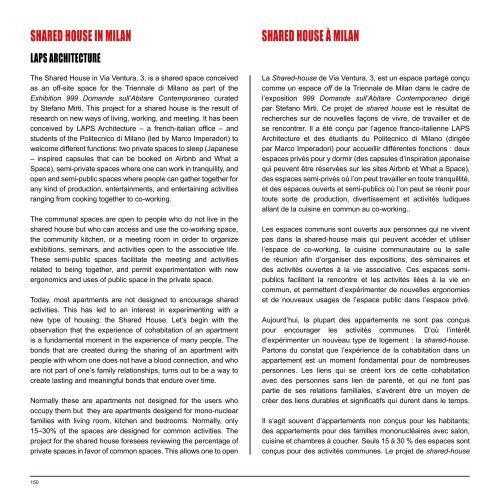What is Co-dividuality?
ISBN 978-3-86859-621-2
ISBN 978-3-86859-621-2
- No tags were found...
Create successful ePaper yourself
Turn your PDF publications into a flip-book with our unique Google optimized e-Paper software.
SHARED HOUSE IN MILAN<br />
LAPS ARCHITECTURE<br />
The Shared House in Via Ventura, 3, <strong>is</strong> a shared space conceived<br />
as an off-site space for the Triennale di Milano as part of the<br />
Exhibition 999 Domande sull’Abitare <strong>Co</strong>ntemporaneo curated<br />
by Stefano Mirti. Th<strong>is</strong> project for a shared house <strong>is</strong> the result of<br />
research on new ways of living, working, and meeting. It has been<br />
conceived by LAPS Architecture – a french-italian office – and<br />
students of the Politecnico di Milano (led by Marco Imperadori) to<br />
welcome different functions: two private spaces to sleep (Japanese<br />
– inspired capsules that can be booked on Airbnb and <strong>What</strong> a<br />
Space), semi-private spaces where one can work in tranquility, and<br />
open and semi-public spaces where people can gather together for<br />
any kind of production, entertainments, and entertaining activities<br />
ranging from cooking together to co-working.<br />
The communal spaces are open to people who do not live in the<br />
shared house but who can access and use the co-working space,<br />
the community kitchen, or a meeting room in order to organize<br />
exhibitions, seminars, and activities open to the associative life.<br />
These semi-public spaces facilitate the meeting and activities<br />
related to being together, and permit experimentation with new<br />
ergonomics and uses of public space in the private space.<br />
Today, most apartments are not designed to encourage shared<br />
activities. Th<strong>is</strong> has led to an interest in experimenting with a<br />
new type of housing: the Shared House. Let’s begin with the<br />
observation that the experience of cohabitation of an apartment<br />
<strong>is</strong> a fundamental moment in the experience of many people. The<br />
bonds that are created during the sharing of an apartment with<br />
people with whom one does not have a blood connection, and who<br />
are not part of one’s family relationships, turns out to be a way to<br />
create lasting and meaningful bonds that endure over time.<br />
Normally these are apartments not designed for the users who<br />
occupy them but they are apartments desigend for mono-nuclear<br />
families with living room, kitchen and bedrooms. Normally, only<br />
15–30% of the spaces are designed for common activities. The<br />
project for the shared house foresees reviewing the percentage of<br />
private spaces in favor of common spaces. Th<strong>is</strong> allows one to open<br />
SHARED HOUSE À MILAN<br />
La Shared-house de Via Ventura, 3, est un espace partagé conçu<br />
comme un espace off de la Triennale de Milan dans le cadre de<br />
l’exposition 999 Domande sull’Abitare <strong>Co</strong>ntemporaneo dirigé<br />
par Stefano Mirti. Ce projet de shared house est le résultat de<br />
recherches sur de nouvelles façons de vivre, de travailler et de<br />
se rencontrer. Il a été conçu par l’agence franco-italienne LAPS<br />
Architecture et des étudiants du Politecnico di Milano (dirigée<br />
par Marco Imperadori) pour accueillir différentes fonctions : deux<br />
espaces privés pour y dormir (des capsules d’inspiration japona<strong>is</strong>e<br />
qui peuvent être réservées sur les sites Airbnb et <strong>What</strong> a Space),<br />
des espaces semi-privés où l’on peut travailler en toute tranquillité,<br />
et des espaces ouverts et semi-publics où l’on peut se réunir pour<br />
toute sorte de production, divert<strong>is</strong>sement et activités ludiques<br />
allant de la cu<strong>is</strong>ine en commun au co-working..<br />
Les espaces communs sont ouverts aux personnes qui ne vivent<br />
pas dans la shared-house ma<strong>is</strong> qui peuvent accéder et util<strong>is</strong>er<br />
l’espace de co-working, la cu<strong>is</strong>ine communautaire ou la salle<br />
de réunion afin d’organ<strong>is</strong>er des expositions, des séminaires et<br />
des activités ouvertes à la vie associative. Ces espaces semipublics<br />
facilitent la rencontre et les activités liées à la vie en<br />
commun, et permettent d’expérimenter de nouvelles ergonomies<br />
et de nouveaux usages de l’espace public dans l’espace privé.<br />
Aujourd’hui, la plupart des appartements ne sont pas conçus<br />
pour encourager les activités communes. D’où l’intérêt<br />
d’expérimenter un nouveau type de logement : la shared-house.<br />
Partons du constat que l’expérience de la cohabitation dans un<br />
appartement est un moment fondamental pour de nombreuses<br />
personnes. Les liens qui se créent lors de cette cohabitation<br />
avec des personnes sans lien de parenté, et qui ne font pas<br />
partie de ses relations familiales, s’avèrent être un moyen de<br />
créer des liens durables et significatifs qui durent dans le temps.<br />
Il s’agit souvent d’appartements non conçus pour les habitants;<br />
des appartements pour des familles mononucléaires avec salon,<br />
cu<strong>is</strong>ine et chambres à coucher. Seuls 15 à 30 % des espaces sont<br />
conçus pour des activités communes. Le projet de shared-house<br />
150


















